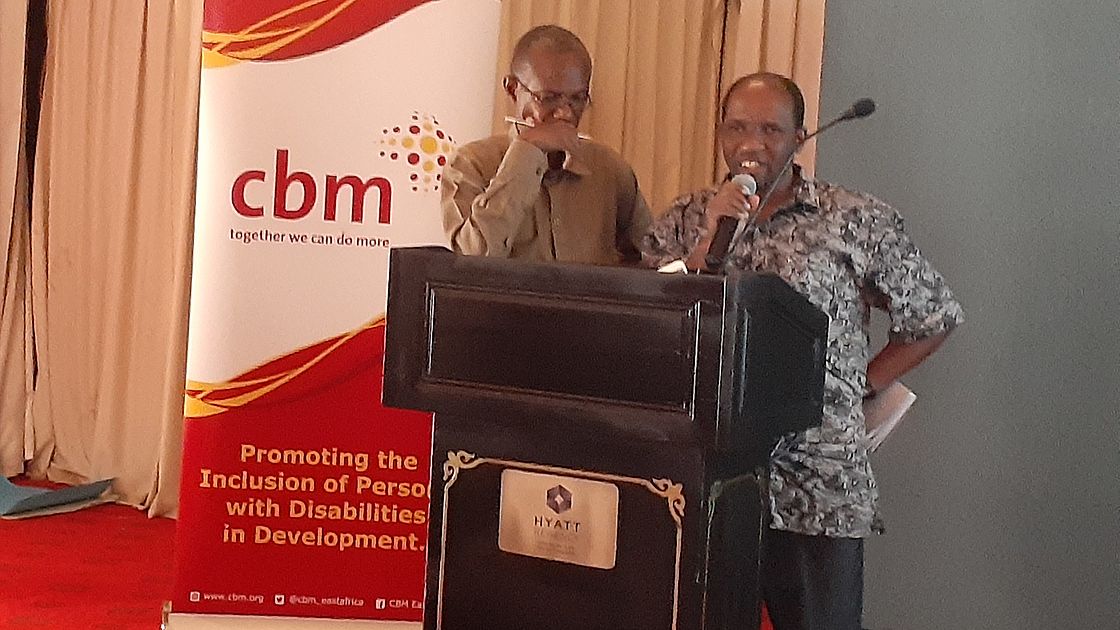08.10.2019 Learnings from interactive workshop on inclusion and equity in eye health
![“Leaving no one behind: strengthening inclusion and equity in eye health” workshop in Dar Es Salaam, Tanzania. 2019©CBM Manfred Mörchen [right with microphone] in a plenary discussion with colleagues from Sightsavers and Light for the World](/fileadmin/_processed_/d/9/csm_Inclusion_in_Health_Workshop_Day_2_f369400a89.jpg)
©CBM
Written by Dr. Manfred Mörchen, Regional Advisor for Inclusive Eye Health
After many months of preparation, CBM and Sightsavers finally met in Dar Es Salaam, Tanzania, for the first day of the interactive workshop “Leaving no one behind: strengthening inclusion and equity in eye health”. We gathered a very diverse group of some of the main stakeholders involved in eye health programs around the world and people with different types of disabilities from Disability People Organizations from Tanzania, such as people with irreversible visual and hearing impairment, albinism and multiple impairments.
Dr. Hannah Kuper from the International Center for Evidence in Disability, London, set the scene by delivering a remote talk about the intriguing relationship of health and disability and the numerous barriers people with disabilities face when accessing health services. Evidence suggests that people with disabilities are more likely to have poor health; for example, their risk of having diabetes is three times higher. The audience was stunned to learn that the life expectancy of women with intellectual impairment, even in high income countries, is almost twenty years lower compared to women without disabilities.
Access to health services needs to be improved urgently, and this was highlighted by many presentations from the participants with disabilities. For example, Emanuel Simon from the Tanzania League for the Blind, explained that beliefs about blindness caused as the result of witchcraft is still common in some communities. Lupi Mwaisaka from the Tanzania Society for the Deaf pointed out that people with hearing impairment often do not understand instructions on how to take medication or apply eye drops. This can have serious consequences, simply because health staff are not trained to communicate with people with hearing impairment! It became obvious that greater effort is needed so that eye hospitals take care of the needs of all their patients, including those with hearing, physical and learning impairments.

Emanuel Simon [right] from the Tanzania League for the Blind, explains that beliefs about blindness as the result of witchcraft are still common in some communities. ©CBM
©CBM
The second and final day of the interactive workshop was shaped by a series of compelling presentations from some of the most experienced stakeholders in the field of inclusive eye health.
Colleagues from Light for the World and Sightsavers introduced participatory tools designed for improving accessible services in hospitals. Special Olympics shared their experiences about working with children and adults with intellectual disabilities, and how to conduct visual acuity checks for people with Down Syndrome, for example.
CBM presented about the difficult relationship of disability and health and advocated to intensify efforts to integrate inclusion in the training curricula of medical schools. Much more still needs to be done to train medical doctors in communication skills with patients with disabilities and to sensitize doctors about the importance of mitigating access barriers to health and eye health services.
The former president of the International Agency for the Prevention of Blindness IAPB, Dr. Hannah Faal, facilitated a session about access to rehabilitation and educational services for patients with irreversible visual impairment. Zoe Grey from the IAPB informed the group that the United Nations Assembly recently highlighted the importance of disability in Universal Health Coverage, a very important step to leverage inclusive health services.
Finally, the workshop concluded with presentations from CBM and Sightsavers about the latest disability data from various low-and-middle income countries. It was encouraging to see that significant improvements were achieved in the integration of data related to disability. For example, data from a CBM supported disability data project in Paraguay suggested that, surprisingly, almost 10% of all patients coming to an eye hospital report severe difficulty with communication. This is important information as steps need to be taken at hospitals to address these communication barriers.